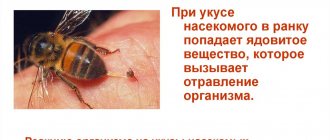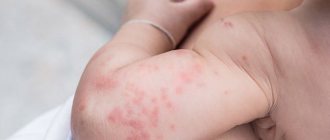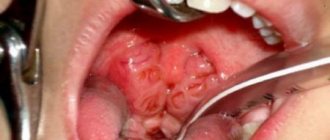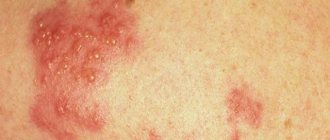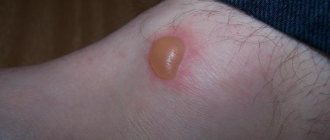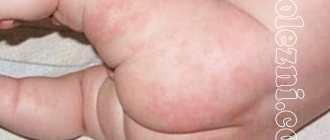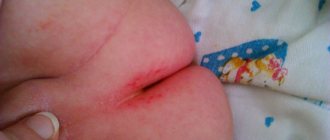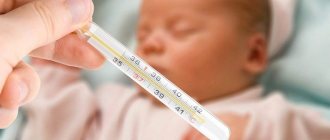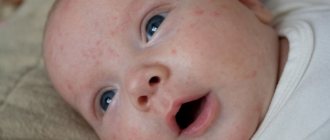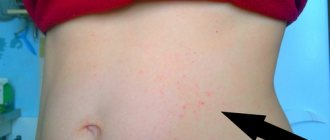The appearance of acne on the nose most often occurs at the most unfortunate moment, simultaneously worsening the mood and appearance of men and women. Failures in the protective function of the skin occur due to its contamination, improper functioning of the sebaceous glands, unhealthy diet or poisoning.
A visit to a cosmetologist and consultation with a dermatologist are important in the modern world.
Acne treatment should be left to the doctor
Many people know what a pimple on the nose means (it doesn’t go away for a long time) according to folk superstitions, but logic and common sense suggest a deeper cause of the problem.
Causes of rashes around the mouth in children
A rash around the mouth in a child of different ages occurs for several reasons:
- excessive salivation;
- violation of hygiene;
- infectious diseases;
- dermatitis;
- helminthic infestation;
- influence of external factors.
A rash around a child’s mouth can be caused by many factors that are important to identify for proper treatment.
Many of these causes are associated with vitamin deficiency and the use of hormonal drugs to treat certain diseases. The impetus for the spread of the rash can be a disruption of the digestive tract. This is both an imperfection of the enzymatic system and functional disorders.
Children of different ages go through several growth spurts. These are the stages of maturation of internal and endocrine organs. Therefore, a rash may appear for some period of time and go away on its own.
Environmental factors
Rash and irritation around a child's mouth often occurs if the skin is exposed to:
- wind;
- ultraviolet radiation;
- humid hot climate.
A baby's skin is very delicate, so it needs to be protected from open sunlight. The result of insolation is the appearance of red spots and rashes. If a child has increased salivation and is outdoors, then when there are gusts of wind, the skin may become chapped, reddened, and covered with dermatological elements.
The increase in symptoms occurs gradually: from the first hours, dry skin appears, then it turns red, and blisters with watery contents appear. When the climate changes or vacations in hot countries, the elements appear due to the onset of excessive work of the sebaceous glands.
Reasons and background
To be 100% sure of how to get rid of acne on the nose correctly and for a long time, first of all you should find out the cause of the disease. This problem can affect every person, regardless of gender and age.
Children suffer from acne mainly due to food poisoning and unwashed fruits and vegetables. In addition, their skin may react to medications, colds and allergies, and other diseases.
A rash under a child’s nose is a reason to go to the doctor. There is no need to experiment with medications, as they may not be accepted by the child, given his fragile body.
The main prerequisite for the appearance of inflammation on the nose in adolescents is a hormonal imbalance in the body caused by puberty. Older people suffer from acne near the nose, the causes of which are associated with disruption of the functioning of organs and systems in the body, and a lack of vitamins.
Rashes may appear due to problems with the gastrointestinal tract.
The skin is protected by a special hydrolipid film, which consists of sebaceous and sweat glands. It may include loose skin cells.
In cases of disruption of the normal functioning of the sebaceous glands, the density of subcutaneous sebum produced by them may increase. In this case, its exit to the outside will be blocked, after which it will clog the pores. It is for this reason that external inflammation begins to appear.
Blackheads are the result of oxidation of subcutaneous sebum, if a clogged pore on the nose comes to the surface. In this case, a comedon (cyst) is formed.
Acne (a large pimple on the nose with red pus) appears during inflammatory processes that can be caused by infections or bacteria, often brought in by the hands of the patient himself during unsuccessful attempts to squeeze it out.
If a pimple appears, the nature of which is difficult to determine on your own, you should not try all the methods in a row, it is better to consult a specialist.
Neonatal acne in newborns
Newborns include children up to 28 days of life. Some mothers notice irritation on the baby's skin during this period, which makes them worry. This condition is typical for 20-30% of children and refers to physiological phenomena.
A rash around a child’s mouth is a consequence of hormonal changes in the body, which begins to live independently.
The second reason for the phenomenon is the proliferation of yeast-like fungi on the surface of the body, which need sebum for nutrition. Externally, it is not difficult to determine that this is acne of the perinatal period. The elements are pointed, with a white shaft in the center. The contents of the vesicle are viscous, which distinguishes clear discharge from herpes infection or dermatitis.
Unlike other causes of its appearance, newborn acne migrates over the face and neck and is not typical for other parts of the body, as with urticaria and miliaria. In addition, there are no signs of intoxication, which would indicate an infectious process.
A pimple popped up under the nose on the left or right: reasons
The exact cause of pimples under the nose in women is unknown. However, in many cases, these bumps are usually caused by one or more of the following reasons:
- Use of certain steroid creams and ointments.
- Certain cosmetics, cleansers and cosmetics applied to the affected area on the face may contain certain ingredients that may cause allergic reactions to the skin under the nose.
- Exposure to harsh cold environmental conditions such as strong winds in cold weather, and exposure to strong ultraviolet (UV) light.
- Fluoridated toothpaste may also cause bumps and pimples under the nose and around the mouth, research shows.
- Yeasts and bacteria that live on the skin and in hair follicles have been suggested as a possible trigger for bumps on the mouth area.
- Hormonal imbalances are also the most well-known cause of acne under the nose in women over 25 to 30 years of age or older.
Recently, research has suggested that some sunscreens used on the face may cause oral dermatitis and pimples under the nose of some children and adults. It is best to use a liquid gel or light milky lotion rather than harsh sunscreens.
Irritation from drooling in infants
Starting at approximately 4 months, the baby begins a period of hypersalivation. Parents notice that the child has a lot of saliva, which hangs like ropes from his mouth. This is due to the start of the salivary glands, although it often coincides with the period of teething.
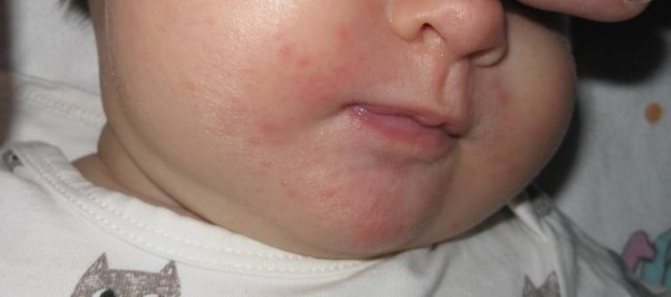
Physiologists believe that this is a protective mechanism that allows you to get rid of microorganisms that get into your mouth with your hands. Due to the constant damp environment, redness and irritation appear on the chin. Mechanical removal of viscous secretion does not produce results.
Hypersalivation can be caused by pathological conditions:
- oral candidiasis;
- helminthic infestation;
- otitis;
- diseases of the central nervous system;
- intoxication as a result of exposure to heavy metal salts.
If a large amount of saliva appears, pathology must be excluded. You need to blot the skin with a disposable or reusable clean scarf.
Treatment options for acne under the nose in women
Pimples under the nose in adult women can be treated with skin whitening creams, laser treatments, or cryotherapy. Acne and eczema can be treated with an over-the-counter medication with lactic acid or benzoyl peroxide. Additionally, your doctor may suggest an emollient moisturizer or calamine lotion to hydrate and soothe the skin. any itching or irritation In severe cases, a drug such as an antihistamine can also be used to treat eczema and allergy symptoms.
Bumps on the corners of the mouth from herpes are treated with topical antiviral medications. For other symptoms, treatment may be done using oral antivirals and non-steroidal anti-inflammatory medications.
Reducing the concentration of the virus reduces the likelihood of other infections. If pimples under the nose are left untreated, herpes infections and other viruses can cause life-threatening complications such as encephalitis.
Atopic dermatitis or infantile eczema
Atopic dermatitis is a reaction to hazardous foods. Redness can occur on the body in the chest area, arms and neck. If the allergen is not excluded, the elements open up, begin to get wet, and the skin becomes very itchy.
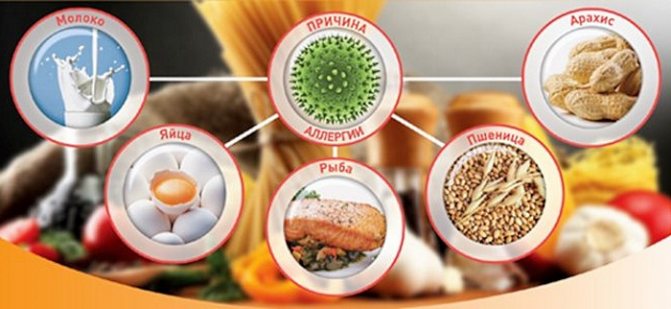
Five foods that cause atopic dermatitis
Genes responsible for predisposition to the development of the disease have been identified. But it can be realized only with an initially low state of immunity. Often, manifestations of pathology begin under the influence of a stress factor. If there are inflammatory skin diseases, traumatic injuries, then this is the entrance gate for infection and allergens.
The cause of the development of dermatitis can be food, respiratory antigens, or the body’s reaction to long-term use of antibiotics.
Tips for proper treatment of atopic dermatitis:
Treatment of formations
If a pimple pops up on your nose, you need to take treatment seriously. This is especially true for acne in men. Representatives of the stronger sex are reluctant to turn to cosmetologists and dermatologists, hoping that the problems will be solved on their own.
If the formations go away naturally, the risk that a scar or post-acne will remain is extremely high.
Pimples on the nose in women and adult girls often occur due to a large amount of androgens, so doctors recommend hormonal contraceptives at the first manifestations of acne.
The need for consultation on how to remove acne on the nose when it appears regularly is to prevent scarring in the future. Sometimes doctors prescribe homeopathic medicines and antibiotic ointments. If pimples around the nose appear regularly and do not go away, then you need to get a course of treatment from a specialist.
To eliminate skin problems yourself, you need to know exactly the irritating factors. So, pimples on the nose can have different causes, but mostly they appear with the development of other diseases.
This is why it is important to conduct clinical examinations. You can understand how to quickly remove a pimple on the nose by determining its nature and character.
Acne indicates a rapidly spreading infection. In order for the formations to pass, you need to take care of your personal hygiene: wash your face at least 2 times a day with mild baby or tar soap (special foam is also suitable). A mild cold pimple on the nose is treated with iodine, Vishnevsky ointment, or antibiotic medications.
Before you clean your skin, make sure you have a clean cloth or disposable paper towel ready. You should wipe your face as carefully as possible. Then the inflamed area is lubricated with a product with a tightening effect (for example, Curiosin or Miramistin-Darnitsa) or cream for oily skin.
Worms
If a child or parents do not follow hygiene rules and allow contact with street animals, then there is a high probability of worms appearing. This phenomenon is typical not only for children from the category of dysfunctional families, due to their activity and great desire to learn about the world around them. This period usually occurs after 1 year.
You can suspect that the rash is associated specifically with worms by the long-lasting rash, which does not decrease even under the influence of medicinal drugs. After therapy, the phenomena disappear on their own, without additional help. As worms multiply, they cause intoxication. It manifests itself as local allergic reactions.
Children are most often characterized by the appearance of 3 types of helminths:
- pinworms;
- roundworm;
- whipworms.
All these parasites belong to the category of nematodes. With helminthiasis, the rash most often has the appearance of acne.
Allergy
Inflammation of the skin around the mouth often appears as a result of allergies. You can suspect this cause if the child has moved from infancy to the junior preschool group, teeth have already erupted, and the rashes are periodic. This means that the body reacts to certain foods , the rest of the time the immune system functions quietly.
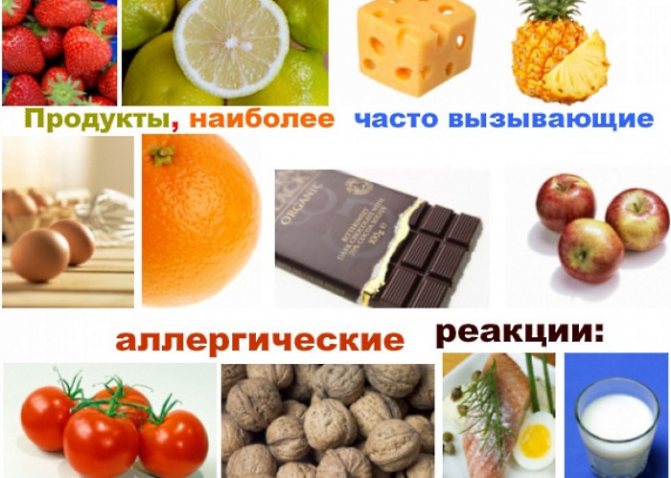
Allergens are divided into several categories, depending on the route of entry. Often with this form of the disorder other symptoms appear: lacrimation, runny nose, swelling of the mucous membranes. The use of anti-cold medications has no effect.
Perioral dermatitis
Perioral dermatitis occurs mainly in young people, under 20 years of age. People who use hormonal-based cosmetics are at risk. In children, the disorder appears in no more than 5% of all cases, followed by peeling and the appearance of small dotted elements with a white dot in the center. Localization of manifestations is the chin, nasolabial triangle.
As the elements spread, they merge with each other and infection occurs. The rash does not cause significant discomfort or itching. If treatment is not started at an early stage, the skin becomes rough and may change color to brown. Subsequently, the restoration of the normal pale pink color of the cover does not occur.
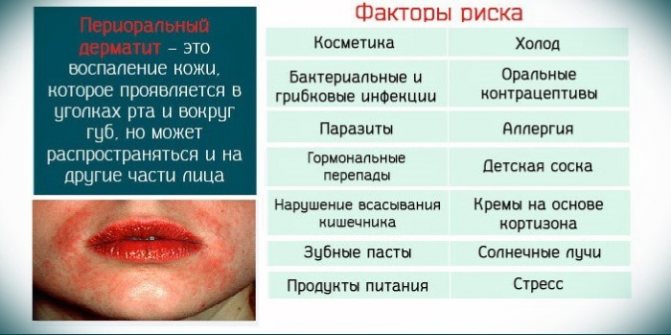
This type of irritation occurs for several reasons:
- decreased immunity;
- the use of hormonal agents to combat dermatitis;
- allergy;
- hormonal changes;
- skin damage from bacteria;
- vitamin deficiency;
- diseases of the gastrointestinal tract;
- use of fluoride-containing paste;
- disruption of the nervous system;
- prolonged exposure to the sun.
The border between diseased and healthy skin is defined as a thin white film.
Types of inflammation and acne
There are the following types of formations:
- White.
- Reds.
- Purulent.
- On the nose.
- Pink.
Whiteheads are small rashes similar to nodules, which are also called prosyanki. In themselves they are not dangerous, but they lead to inflammatory processes.
Children suffer from acne mainly due to food poisoning
To remove white pimples, it is best to undergo an electrocoagulation procedure.
A special device burns out the external source of inflammation in one session without bleeding or side effects for the epithelium. After the procedure, the skin must be treated with antiseptics to prevent the appearance of scars.
A red pimple on the nose hurts if it appears due to inflammatory processes in the cyst. This type of rash is similar to an internal or subcutaneous pimple on the nose, which ripens for a long time and is accompanied by a slight pain when pressed.
When adjacent to several similar red formations, they merge. It is better to get rid of this disease with the help of antiseptic and anti-inflammatory ointments. In some cases, antibiotics are recommended.
A purulent pimple on the nose is the next stage in the development of a red formation when it gets infected with staphylococcus. If you notice the first signs of a purulent area, you should immediately contact a specialist. This painful type of acne is treated with a complex of ointments for external use, antibiotics, and vitamins.
A rash under a child's nose is a reason to go to the doctor
It is strictly forbidden to perform manual manipulations on your own, as this can lead to a deterioration in the general condition and even death. Pre-medical care may consist of the use of Vishnevsky ointment or a drying antibacterial and antiseptic drug.
A pimple on the wing of the nose is a sign of an exacerbation of the herpes virus. Such inflammations constantly itch, and they can be eliminated with complex treatment prescribed by a dermatologist, so the method of therapy does not matter. Pimples on the wings of the nose cannot be left without attention and proper treatment. Delay can cause thickening and roughening of the skin.
Bites may appear due to problems with the gastrointestinal tract. The failure of one of the systems creates the necessary conditions for active reproduction of the tick.
Herpes
Decreased immunity can be caused by viral and bacterial infections. Often a sign of unstable functioning of the protective system is a herpetic rash. These are small elements with watery contents. The appearance of herpetic elements in an infant is a very unfavorable sign.
As a rule, infection occurs through direct contact with close relatives during an exacerbation period.
Since immunity is just being formed, innate immunity and protective factors contained in breast milk protect for up to 6 months, herpetic eruptions may indicate congenital pathologies with an immunosuppressive effect.
An exacerbation of the infection is typical after the age of 3 years , when the child begins to visit kindergartens, come into contact with various bacteria and viruses, and enters the social sphere.
Other causes of rash around a child's mouth
If there are no signs of allergies, dermatitis or enterovirus infection, then the appearance of irritation may be associated with individual characteristics of digestion. In this case, the child has unstable stools, a tendency to constipation, and particles of undigested food in the stool. This may occur due to inappropriate nutrition for the child's age.
The most common cause of the disorder is infection. The aggressive factor is staphylococcus, an element of normal microflora. With hypothermia and decreased immunity, it begins to multiply on the skin, causing a pustular rash on the face and other parts of the body.
Fungal flora also reacts to decreased immunity. If the mother had thrush during pregnancy, which was not completely cured at the time of birth, then candida remains on the surface of the body and can appear at any time. A sign of a fungal infection is the presence of white or yellowish patches that peel off when rubbed.
If there is a strong wind outside and the face is not protected, then foci of peeling appear on the chin and in the perioral area. This is caused by chapping of the surface of the skin.
Violation of personal hygiene rules is an additional factor in changes in the condition of the protective cover. If you touch your mouth with unwashed hands, bacteria begin to multiply on the mucous membrane.
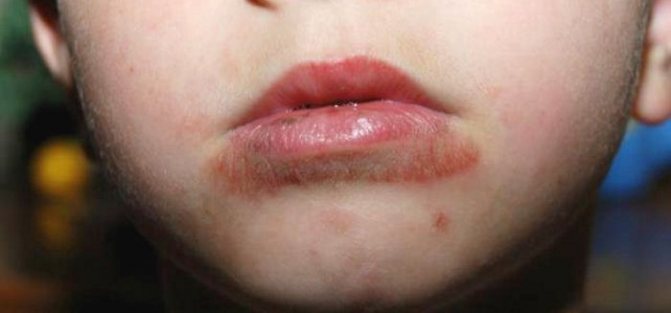
Other reasons may be:
- allergy to the latex from which the pacifier is made;
- consequence of vaccination;
- insect bite
The main sign indicating the category of rash is the nature of the rash and the presence of auxiliary symptoms.
Symptoms of acne under the nose
Pimples under the nose can vary in color, texture and size. Some may be flat to the skin, while others may be large, raised bumps. They can range in color from brownish black to bright red with a white pus-filled head at the end. Symptoms of these pimples may also include itching, swelling, scaling, inflammation, sensitivity and pain Facial blemishes may also contain pus that rises to the surface of the skin Similar pimples and blemishes may also appear on other areas of the face and body, but their appearance under the nose may both coincide with the reasons for their appearance in other areas of the face, and have certain differences.
What does the color and type of rash indicate?
All types of rash are different. Therefore, the external manifestations of the elements can tell the doctor a lot. A pinpoint rash often indicates an infectious process and intoxication. If it is filled with fluid, it is caused by the herpes virus.
When the rash is detected only in one place, the cause is most often local in nature . If elements appear on the back, arms, neck, then the matter is in internal processes.
Based on the appearance of the manifestations, one can suspect the cause of the phenomenon:
| Disease | Appearance of the rash |
| Perinatal acne | Small elements with a white rod inside. Contents viscous |
| Atopic dermatitis | The elements merge with each other, the surface of the skin is red and peeling |
| Herpes | Bubbles of different sizes, filled with clear liquid |
| Allergy | Elements rise above the surface of the skin, the skin around is red, there is no content inside |
| Weathering | Characterized by redness of the skin, areas of peeling and itching |
| Worm infestation | The rash is pinpoint, elements without content, appear in the area of the nasolabial triangle, neck |
| Perioral dermatitis | At first, the elements are located separately, then merge with each other, pus appears, wet areas appear, the surface peels off |
When redness and peeling are observed, this is a sign of the allergic nature of the disorder. If the affected area is large, the specialist suspects toxic erythema. The purulent contents of the vesicle indicate infection, a bacterial complication.
Regardless of the type of rash, they occur on initially intact skin. The intensity and location of the process determine the type of elements. Each characterizes a disruption in the functioning of the entire organism.
Types of acne under the nose
There are several types of rashes under the nose. They differ in size, appearance, quantity and reasons for their appearance. Thus, small white pimples and blackheads usually occur due to lack of care.
They are sebum or dirt particles trapped in the pores.
White pimples are formed when a pore is clogged; subsequently they often become purulent and significantly increase in size, drawing surrounding tissues into the inflammatory process.
Diagnostic methods
A rash around a child’s mouth is classified as belonging to a specific type using the same type of research according to the algorithm:
- general blood analysis;
- immunological study for antibodies to the suspected infection;
- general urine analysis;
- prick allergy test;
- stool analysis for worm eggs.
Since a number of conditions are caused by contact with an allergen, conducting a test reduces the time to search for the type of pathogen. An important type of diagnosis is to examine the nature and color of the rash. He tells you what microorganisms it is caused by.
Treatment with drugs depends on the cause of the rash
A rash around a child’s mouth is treated taking into account the cause that caused it. There is no universal remedy that would help in all cases.
Some measures help prevent the development of the disorder:
- compliance with hygiene rules;
- early contact with a doctor;
- for dry skin, you need to use nourishing creams;
- before going outside during the cold period, you need to apply a protective cream;
- use only children's clothing and body care products;
- reduce the time a child spends outdoors in the open sun in summer.
Therapy for the disorder must be comprehensive. These are local and systemic remedies. At all stages of treatment, it is necessary to monitor whether the patient’s condition improves. Once the type of pathogen is determined, etiological treatment is prescribed. It involves antibacterial or antiviral treatment that is active against this pathogen.
In most cases, physiotherapy methods are included in therapy. They help improve local blood flow and have an anti-inflammatory effect. The possibility of using alternative medicine should be checked with a doctor.
Cosmetological methods
An experienced cosmetologist will tell you how to get rid of acne on the nose and recommend various procedures. Contacting a specialist is reasonable if there is a large affected area on the face, or if the patient notices that abscesses and inflammation appear regularly.
There is no need to sound the alarm because of one painful pimple (unless it is a boil) and you can cure it yourself with the help of Zinerit or Vishnevsky ointment. There are a great many similar drugs on the market.
Rashes under the nose and in the area of the entire nasolabial triangle can be treated with procedures such as peeling, cryotherapy, mesotherapy and ozone therapy.
These techniques are used for a wide range of skin problems (some of the above also help hair), but let's look at their functions for those situations when a pimple has popped up on your nose.
Ozone therapy is most often used due to the comfort of the procedure. To remove subcutaneous acne without leaving scars or other damage to the skin, you should use only this method. The essence of the technology is to eliminate microbes.
One ozone-oxygen injection causes a pimple that has popped up on the nose to mature in a few hours, eliminating painful sensations. At the same time, the drug causes active production of collagen and elastin.
These substances promote rapid healing of the skin. For the same purpose, the infected area of skin after the injection is treated with ozonated distilled water.
Peeling is a skin cleansing procedure that smoothes the top layer of epithelium. Removal of defects occurs due to special acids that remove all contaminants accumulated in the pores. Then a complex of various creams and masks is used, with which you can cleanse and protect the skin.
Peeling will be effective in eliminating the white appearance of acne. Since this procedure helps get rid of scars and other unsightly consequences, it is especially useful in treating skin problems in men, since they are often inactive with acne.
For those who sometimes experience acne, facial cleansing is recommended. Cosmetologists distinguish 2 types: mechanical (manual) and hardware technologies. An experienced specialist is able to remove acne on the nose quickly and relatively painlessly, soothing and disinfecting the skin properly.
Please note that after cleansing the face, the skin may experience redness for several days.
A pimple under the nose can be eliminated in a more extravagant way: facial cryomassage or cryotherapy. This is cold treatment. When the infected area is treated with liquid ozone, pimples are able to disappear almost instantly.
Mesotherapy consists of injections of special drugs, the effect of which is aimed at narrowing pores. As a result, wrinkles are reduced and the face is rejuvenated. Mesotherapy can also be used to treat skin abscesses.
Folk remedies for treating rashes around a child’s mouth
Traditional medicine has proven itself to be a simple, inexpensive and safe way to cope with various types of problems. It is not always acceptable for young children, due to the high likelihood of allergies to herbs. When a rash appears around the mouth, products with anti-inflammatory and antiseptic effects help.
For example, the following can cope with perioral dermatitis:
- a decoction of string, St. John's wort, chamomile or sage in the form of lotions on the affected areas every 4-5 hours.
- lubricating the elements with propolis boiled in a water bath;
- using a mixture of honey, flax and onion juice, taken in equal volumes, boiled for 10 minutes. and cooled to room temperature;
- using lotions with soda solution (1 tsp per 1 cup of warm water);
- lotions with pulp or juice of fresh pumpkin;
- application of oak bark decoction topically.
Before using any product for the first time, you need to do a sensitivity test. To do this, apply a decoction to an inconspicuous area of skin and wait for 2 hours for the appearance of inflammation.
The following remedies can also help with atopic dermatitis:
- A mixture of rice starch, glycerin and milk, taken in equal proportions and mixed until smooth. Use as an ointment at night and store in the refrigerator.
- Raw, finely grated potatoes, used as a lotion.
- Mix 2 parts of crushed Kalanchoe leaves with 1 honey and stir. The paste is applied 2-3 times a day to the affected areas of the body. This method is effective, but is used with caution due to the high allergenic properties of honey.
- Celery root juice with salt and a few drops of vinegar is applied as a lotion to the skin 3-4 times a day. After 3 years, it is allowed to take 20 ml orally 2 times daily.
- Cucumber juice is applied every 2-3 hours, which helps moisturize the area and relieve inflammation.
- If 1 tsp. Boil chamomile in a water bath with the addition of 100 g of vegetable oil, then the resulting composition can be lubricated on the rash areas up to 3 times a day.
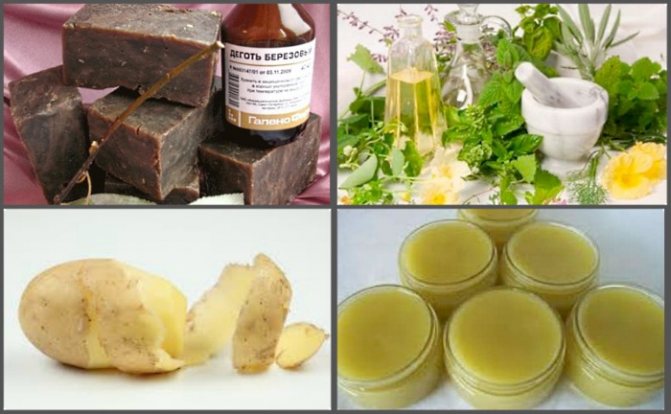
Tar, celandine, mash, potatoes are folk remedies that are used in the fight against atopic dermatitis
If your child has chapped lips and the skin around them, you can try to relieve the pain by using vitamin masks. They are used for shallow damage to the epidermis.
The available means are:
- chamomile ointment prepared at home;
- a mixture of liquid honey, vitamin A and E;
- mask made from sour cream or cream with a high degree of fat;
- Vaseline oil mixed with sea buckthorn and apricot oil.
A rash around the mouth, in the area of the nasolabial triangle in a child often occurs as a result of a combination of several factors. Monitoring the child helps to quickly determine the cause of the disorder, which helps avoid unpleasant consequences and complications.
Author: V.L. Dyleiko
Design: Anna Fleyman
Types of rashes on the face in children of different ages
As already noted, the rash can be primary or secondary. Primary rashes are of greatest interest because they are the most common. It is with their diagnosis that difficulties arise. Based on shape and appearance, the following varieties are distinguished:
- Tubercles are non-hollow lumps on the skin.
- Blisters are dense areas that rise above the level of healthy skin. Blisters are an allergic reaction to poison from plants and insects.
- Papules, or nodules, are non-hollow elements that differ in height and color from healthy skin. They usually go away on their own.
- Bubbles are small pimples. They have a pronounced center filled with cloudy liquid.
- Bubbles are large formations (from 0.5 cm).
- Pustules are pimples filled with pus.
- Spots are changes in the color of the skin.
- Roseola are small pink or red spots that disappear when you apply pressure to the affected area.
Roseola nursery
Red rash
Acne can also appear in a child due to poor hygiene. If the baby is covered with bright pimples, then this is a skin reaction to pollution, to which children are especially susceptible in the first 6 years of life. To prevent your child from becoming covered with a painful crust on delicate areas of the skin, carefully monitor the baby’s cleanliness and accustom him to water procedures.
A consequence of unfavorable thermal effects is hyperhidrosis, or prickly heat. It manifests itself most clearly in infants, starting at one month of age. The baby’s body has not learned to adapt to the ambient temperature, so spots appear on his head and shoulders from sweat. All treatment comes down to frequent exposure of the little patient to the fresh air and regular ventilation of the premises.
Red spots on the forehead, cheeks and shoulders are often a sign of allergies. During lactation, this means that the mother should adjust her diet and also abandon aggressive household chemicals.
Allergic rashes
Red pimples in a child are also observed with toxic erythema. The rash occurs in the facial area: on the head, forehead, cheeks, nose. Newborns and babies under one year of age are most susceptible to it. This type of rash does not require specific treatment and disappears on its own within 7-8 days. At a later age, erythema is rare and, as a rule, is a consequence of uncomfortable living conditions: humidity, ambient temperature.
READ ALSO: How to quickly treat a boil at home: folk remedies
As mentioned above, red rashes can be infectious in nature and observed in the following diseases:
- measles;
- rubella;
- scarlet fever;
- chickenpox.
Chicken pox rash
The most dangerous possible cause of skin changes is meningitis. The disease is severe and in some cases is fatal. A characteristic feature of the infection is a rapid increase in body temperature and the gradual spread of an itchy rash throughout the body. If you have the slightest suspicion of meningococcal infection, you should immediately consult a doctor.
White pimples
Milia, or white pimples, are a type of acne that occurs in adolescents during hormonal changes. They are a small cyst formed as a result of excess sebum. Appear on the cheeks, nose, forehead. The causes of milia are varied: poor diet, poor-quality cosmetics, hormonal imbalance. As a rule, rashes disappear on their own with age (at 15-16 years of age). If not, you should visit a dermatologist or endocrinologist.
The predominant localization of milia is the area around the eyes, cheekbones, and T-zone (forehead-nose-chin). It is impossible to squeeze out such a tubercle - the source is deep under the skin. To get rid of white pimples on the face, you need to adjust your diet and provide quality skin care by choosing products that correct the functioning of the sebaceous glands.
Similar rashes also occur in newborns and go away on their own within 1-2 months of life.
Milia in a newborn
Colorless rashes
Small colorless rashes that resemble nodules are called neonatal acne. Neonatal cephalic pustulosis appears on the face of children during the first month of life. This is how the baby’s skin reacts to the remnants of maternal hormones. No specific treatment is required - the baby will soon adapt to new living conditions. Acne usually goes away on its own within a few days, weeks or 1 year.
Colorless or flesh-colored watery pimples on the cheeks in later life may indicate a malfunction in the immune system: this is how a food allergy or reaction to emotional stress manifests itself. This phenomenon is called dyshidrosis. In emotionally stable children, it goes away on its own; otherwise, therapy is required, including the use of weak sedatives.
READ ALSO: STIs: types, symptoms, diagnosis and treatment in Altufyevo, Vladykino, Otradnoye
Minor rash
If the fever is accompanied by low-grade body temperature (from 37.0 to 37.5 °C), allergic hyperemia, a systemic disorder or a sluggish infection occurs. In the presence of dermatological diseases (pyoderma, erythema, urticaria), body temperature may not increase.
Large purulent blisters
The appearance of purulent blisters can be caused by various factors:
- hormonal disorders;
- compaction of the apex of the epidermis - hyperkeratosis;
- improper skin care;
- abuse of low-quality decorative cosmetics;
- frequent stress;
- unbalanced diet;
- disorders of the gastrointestinal tract.
Other types of rashes
Almost every person is familiar with acne on the face firsthand. They can appear at any age and significantly spoil plans. Children with immature immunity and during the period of hormonal changes are most prone to the appearance of acne and rashes (see also: photos of rashes and other manifestations of measles in children). In most cases, acne on a child’s face is normal, but sometimes a rash is a sign of dangerous pathologies.
Skin rashes in adolescents are a normal variant during the period of hormonal changes in the body
If the symptoms are not similar to any of the cases described above, you should pay attention to the table with explanations of other types of rashes.
| Type of rash | Description | Possible diagnoses |
| Ulcer | A deep defect of the skin and mucous membranes with the obligatory formation of a scar. | Diabetes, anemia, cancer, aerobic infections. |
| Crust | The dried contents of pustules, blisters or ulcers. | Herpes, eczema, diathesis. |
| Flake | Loosened horn cells. The skin is severely peeling at the affected area. Often localized on the head. | Ichthyosis, fungal infection, tinea versicolor. |
| Lichenization | Thickening, compaction, dry skin, pigmentation. The skin pattern is clearly visible. | Lichenification. |
